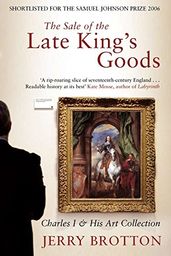Synopsis
Set against the backdrop of war, revolution, and regicide, and moving from London to Venice, Mantua, Madrid, Paris and the Low Countries, Jerry Brotton’s colourful and critically acclaimed book, The Sale of the Late King's Goods, explores the formation and dispersal of King Charles I’s art collection. Following a remarkable and unprecedented Parliamentary Act for ‘The sale of the late king’s goods’, Cromwell’s republican regime sold off nearly 2,000 paintings, tapestries, statues and drawings in an attempt to settle the dead king’s enormous debts and raise money for the Commonwealth’s military forces.
Brotton recreates the extraordinary circumstances of this sale, in which for the first time ordinary working people were able to handle and own works by the great masters. He also examines the abiding relationship between art and power, revealing how the current Royal Collection emerged from this turbulent period, and paints its own vivid and dramatic picture of one of the greatest lost collections in English history.
Details
Reviews
Brotton has taken on a cracking good story, confidently snaking through the complicated politics of seventeenth-century European art-dealership, from Venice and the Low Countries to the Escorial and back into the side-streets of turbulent London and the thousand-odd rooms of Whitehall Palace. He beds this vast mass of convoluted activity with its great cast of characters from de Critz to Van Dyck – its rivalries, frauds, enthusiasms, bankruptcies, brinkmanship and U-turns – deeply into the political, social and artistic context of the time. This is no pillow book: that Brotton maintains his authorial grip on both the grand sweep and the elaborate detail while controlling the drive of his multi-layered narrative is a superb achievement
Provocative . . . admirably researched and compellingly narrated
Jerry Brotton, a young historian with an enviable command of the secondary literature, both historical and art-historical, and a good understanding of the way objects and works of art assume ideological significance, has told the amazing story of Charles I’s collection and its subsequent sale in full
Jerry Brotton holds a magnifying glass to the amassing of the royal collection and its later dispersal . . . bustles with fascinating detail
